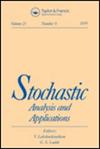Modeling social media addiction with case detection and treatment
IF 0.7
4区 数学
Q3 MATHEMATICS, APPLIED
引用次数: 1
Abstract
Abstract Introduction This paper discusses the problem of social media addiction that pose a major threat to the human population especially children and teenagers. It is well known that Cognitive Behavioral Therapy (CBT) is an effective treatment to treat the addict individuals and delay in the treatment leads the patient to worst stage even to death. Therefore, it is important to identify the individuals who has addiction symptoms at early stage and to provide proper counseling. Method We propose and analyze a nonlinear mathematical model for social media addiction problem using case detection strategy to reduce the addiction. The basic reproduction number and equilibria of the model are computed. Further, the deterministic model is extended to delay differential equation model by incorporating transmission delay and treatment delay in the system. The local stability of different equilibria is discussed in detail. Additionally, the model is converted to stochastic model and numerical simulation is carried out to compare the results of both deterministic and stochastic model. Results Numerical result shows that the introduction of time delays can destabilize the model system and Hopf bifurcation occurs due to periodic oscillations when certain equilibrium point crosses the delay threshold limit. Our results of stochastic model show a smaller number of social media users and addict population when compared with deterministic model. Also, our results reveal that detection and counseling parameters play a vital role in reducing addiction population. Discussion Presented results clearly suggest that there is a need to use effective detection strategy and suitable counseling program to reduce the social media addiction level.用病例检测和治疗建模社交媒体成瘾
摘要引言本文讨论了社交媒体成瘾问题,社交媒体成瘾对人类尤其是儿童和青少年构成了重大威胁。众所周知,认知行为疗法(CBT)是治疗成瘾个体的有效方法,延迟治疗会导致患者进入最糟糕的阶段甚至死亡。因此,在早期识别有成瘾症状的人并提供适当的咨询是很重要的。方法我们提出并分析了社交媒体成瘾问题的非线性数学模型,使用案例检测策略来减少成瘾。计算了模型的基本繁殖数和平衡点。此外,通过在系统中引入传输延迟和处理延迟,将确定性模型扩展为延迟微分方程模型。详细讨论了不同平衡点的局部稳定性。此外,将模型转换为随机模型,并进行了数值模拟,以比较确定性和随机性模型的结果。结果数值结果表明,时滞的引入会使模型系统不稳定,当某一平衡点超过时滞阈值极限时,由于周期性振荡会产生Hopf分岔。我们的随机模型结果显示,与确定性模型相比,社交媒体用户和成瘾人群的数量更少。此外,我们的研究结果表明,检测和咨询参数在减少成瘾人群方面发挥着至关重要的作用。讨论提出的结果清楚地表明,有必要使用有效的检测策略和适当的咨询程序来降低社交媒体成瘾水平。
本文章由计算机程序翻译,如有差异,请以英文原文为准。
求助全文
约1分钟内获得全文
求助全文
来源期刊

Stochastic Analysis and Applications
数学-统计学与概率论
CiteScore
2.70
自引率
7.70%
发文量
32
审稿时长
6-12 weeks
期刊介绍:
Stochastic Analysis and Applications presents the latest innovations in the field of stochastic theory and its practical applications, as well as the full range of related approaches to analyzing systems under random excitation. In addition, it is the only publication that offers the broad, detailed coverage necessary for the interfield and intrafield fertilization of new concepts and ideas, providing the scientific community with a unique and highly useful service.
 求助内容:
求助内容: 应助结果提醒方式:
应助结果提醒方式:


